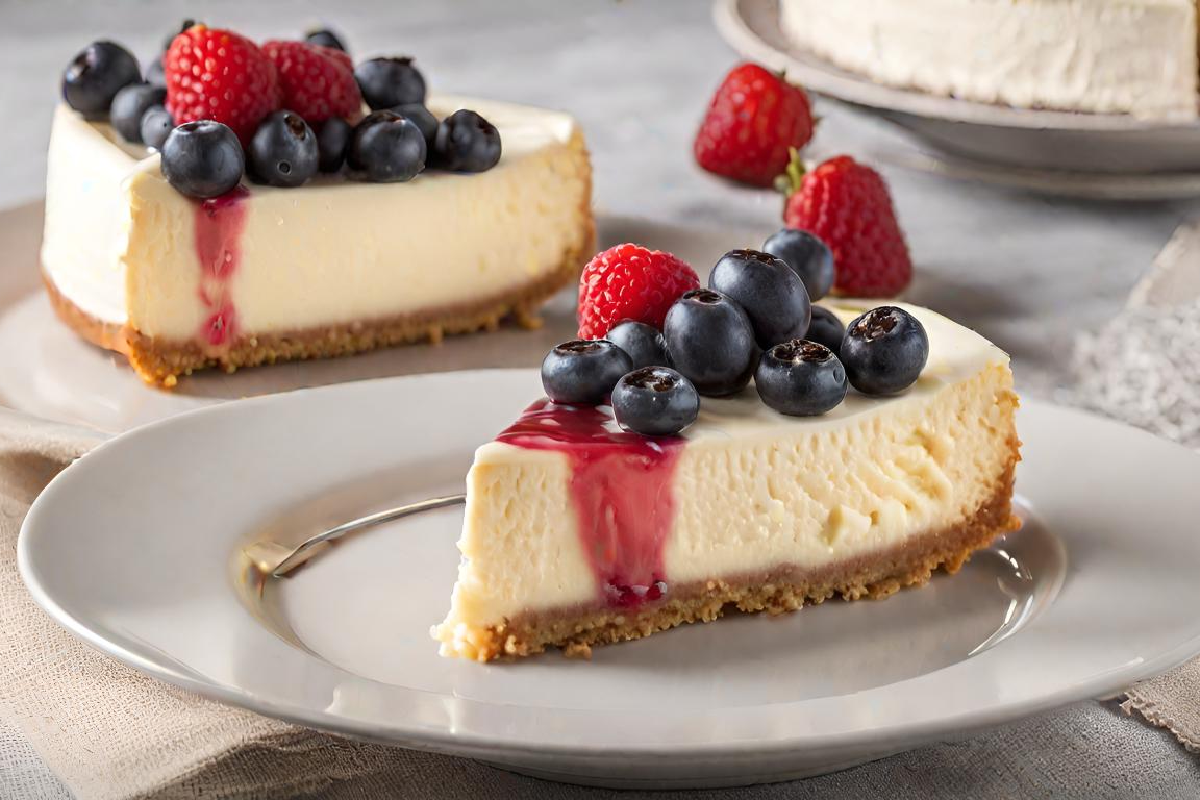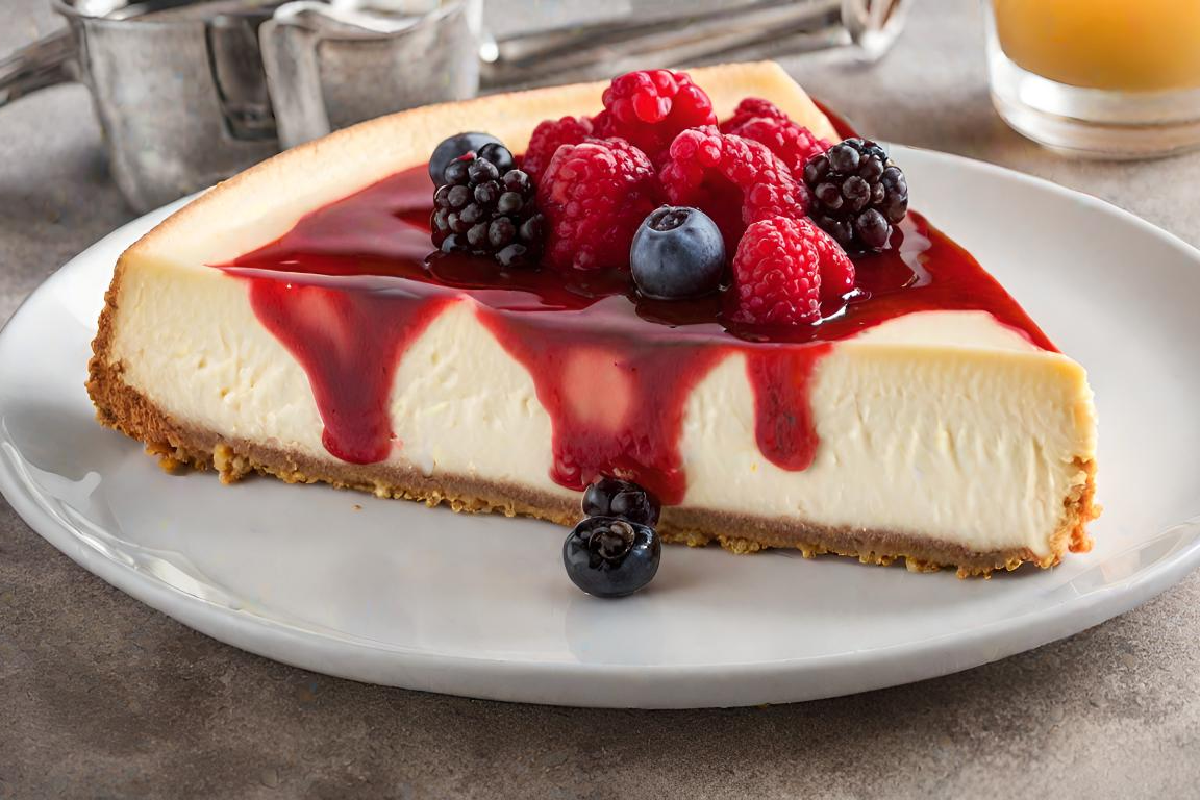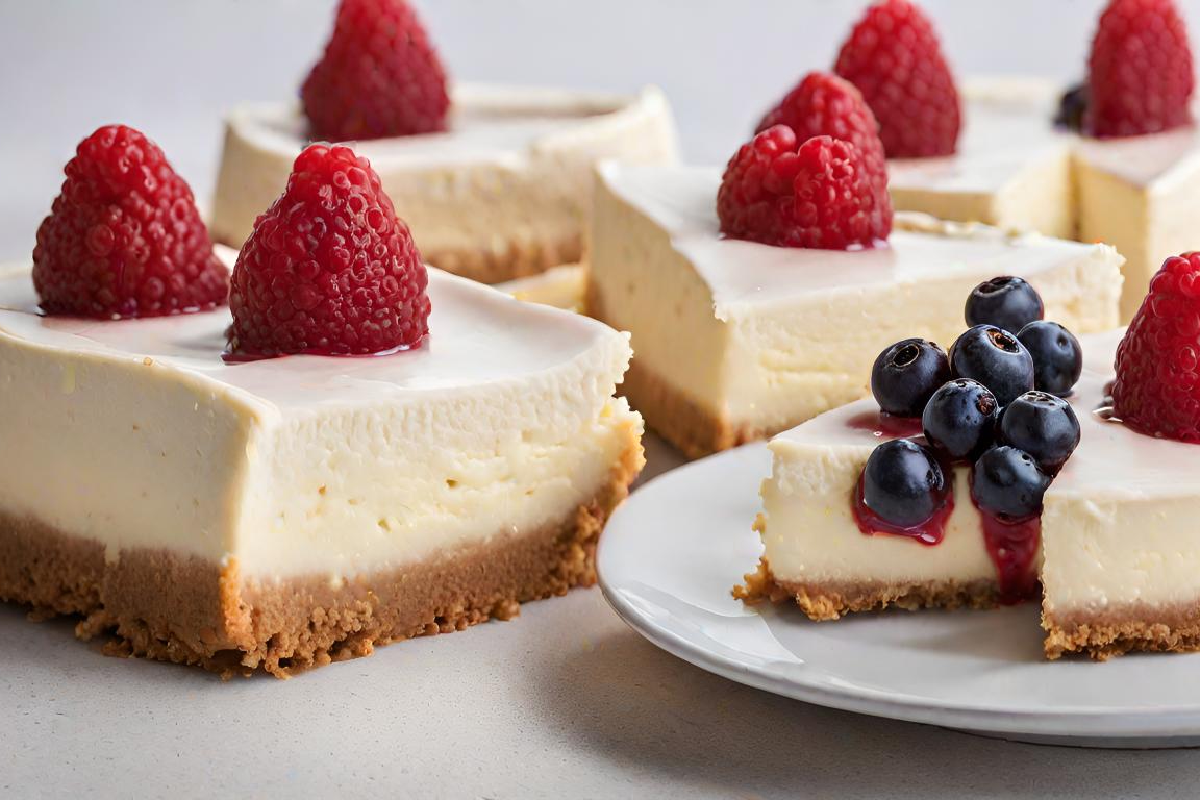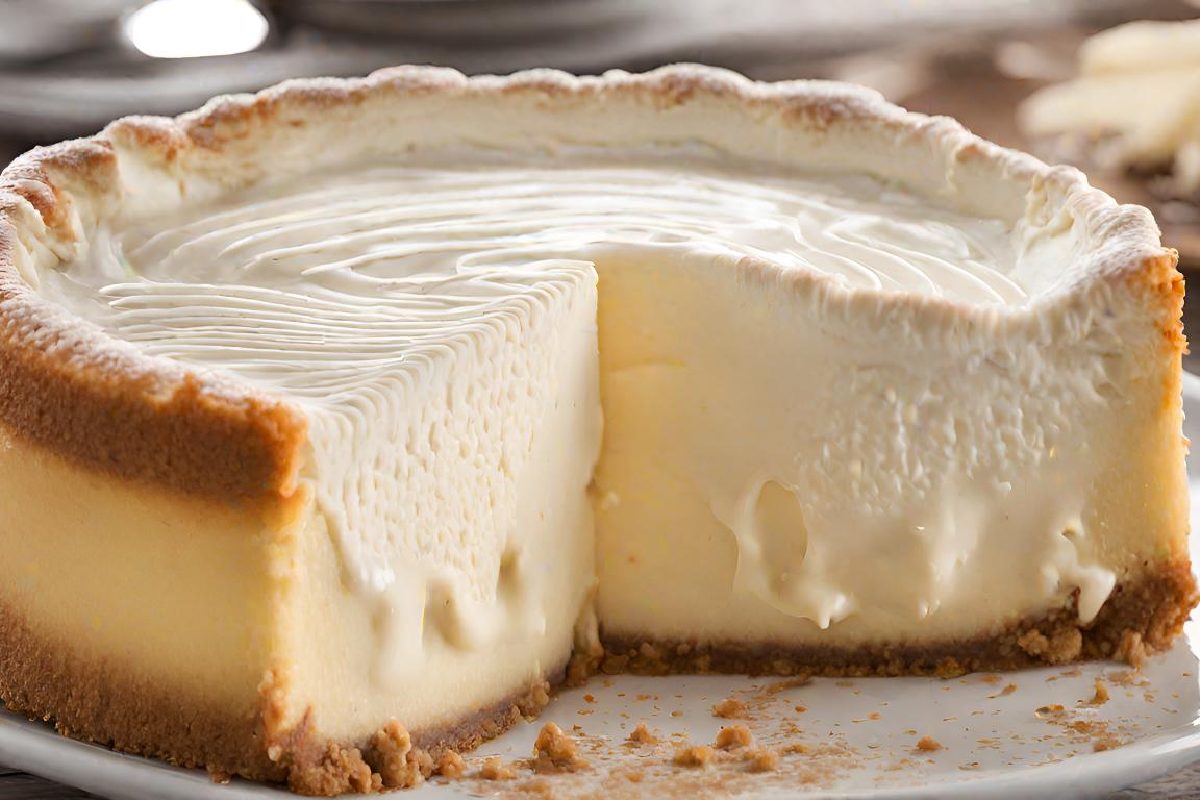Philadelphia cheesecake is a beloved dessert that has been enjoyed by people for decades. It is a creamy and smooth dessert that is made with a graham cracker crust and a filling that is rich and decadent. The cheesecake filling is the star of the show and is what makes this dessert so special.
The filling of Philadelphia cheesecake is made with cream cheese, sugar, eggs, and vanilla extract. Cream cheese is the key ingredient that gives the cheesecake its creamy and smooth texture. The sugar adds sweetness to the filling, while the eggs help to bind everything together. Finally, the vanilla extract adds flavor and aroma to the cheesecake filling. These simple ingredients come together to create a dessert that is loved by millions of people around the world.
The exact recipe for Philadelphia cheesecake filling may vary depending on the chef or the brand of cream cheese used. However, the basic ingredients remain the same. Understanding what goes into the filling of this classic dessert can help you appreciate it even more. Whether you are a fan of cheesecake or just curious about the ingredients that go into it, learning about the filling of Philadelphia cheesecake is a fascinating topic.

Basic Ingredients
Philadelphia cheesecake filling is a creamy and delicious mixture that is used to make the classic Philadelphia cheesecake. The filling is made up of a few basic ingredients that come together to create a rich and creamy texture. Here is a breakdown of the main ingredients in Philadelphia cheesecake filling:
Cream Cheese
The most important ingredient in Philadelphia cheesecake filling is cream cheese. Cream cheese is a soft, mild-tasting cheese that is made from a mixture of milk and cream. It has a smooth and creamy texture that makes it perfect for cheesecake filling. Philadelphia cream cheese is the most popular brand of cream cheese used for making cheesecake filling.
Sugar
Another key ingredient in Philadelphia cheesecake filling is sugar. Sugar is used to sweeten the filling and balance out the tangy flavor of the cream cheese. Granulated white sugar is the most commonly used type of sugar in cheesecake filling.
Eggs
Eggs are also an important ingredient in Philadelphia cheesecake filling. They help to bind the filling together and give it a smooth and creamy texture. Large eggs are typically used for making cheesecake filling.
Vanilla Extract
Finally, vanilla extract is added to the filling to enhance the flavor. Vanilla extract is made by soaking vanilla beans in alcohol. It has a sweet and floral flavor that pairs well with the cream cheese and sugar in the filling.
Overall, Philadelphia cheesecake filling is made up of just a few simple ingredients that come together to create a rich and delicious dessert.
Common Variations
Philadelphia cheesecake filling is a versatile and delicious ingredient that can be used in a variety of desserts. While the classic recipe calls for cream cheese, sugar, and vanilla extract, there are many variations that can add unique flavors and textures to the filling.
Sour Cream
One common variation is to add sour cream to the filling mixture. This can give the cheesecake a tangy flavor and a slightly lighter texture. To make this variation, simply replace a portion of the cream cheese with an equal amount of sour cream. For example, if the recipe calls for 16 ounces of cream cheese, you could use 12 ounces of cream cheese and 4 ounces of sour cream.
Lemon Juice
Another popular variation is to add lemon juice to the filling. This can give the cheesecake a bright, refreshing flavor that pairs well with fresh fruit or a graham cracker crust. To make this variation, simply add a few tablespoons of fresh lemon juice to the filling mixture along with the other ingredients.
Fruit Purees
Finally, fruit purees can be added to the filling to create a variety of flavors. Some popular options include strawberry, raspberry, and blueberry purees. To make this variation, simply blend fresh or frozen fruit with a little sugar and add it to the filling mixture. This can give the cheesecake a beautiful color and a delicious fruity flavor.
Overall, there are many variations of Philadelphia cheesecake filling that can be used to create unique and delicious desserts. By experimenting with different ingredients and flavors, you can create a cheesecake that is perfect for any occasion.

Crust Components
Graham Cracker Base
The graham cracker base is an essential component of Philadelphia cheesecake filling. It provides a crunchy texture and a slightly sweet flavor that complements the creamy filling. The graham cracker base is made by crushing graham crackers into fine crumbs and mixing them with melted butter and sugar. The mixture is then pressed into the bottom of a baking dish to form a solid crust.
Butter
Butter is another crucial component of the graham cracker base. It provides a rich and buttery flavor that enhances the overall taste of the cheesecake. The butter is melted and mixed with the graham cracker crumbs and sugar to form a thick and sticky mixture. The butter also helps to bind the crumbs together and create a solid crust.
Sugar
Sugar is the final component of the graham cracker base. It adds sweetness to the crust and complements the tangy flavor of the cheesecake filling. The amount of sugar used in the crust can vary depending on personal preference, but typically ranges from 1/4 to 1/2 cup. The sugar is mixed with the graham cracker crumbs and melted butter to form a sweet and sticky mixture that is perfect for creating a solid crust.
Texture and Consistency
Philadelphia cheesecake filling is known for its smooth and creamy texture, making it a popular choice for desserts and baked goods. The texture is achieved through a combination of ingredients, including cream cheese, sugar, and eggs. The cream cheese is softened and blended with the sugar until it is smooth and creamy. Eggs are then added to the mixture, which helps to bind the ingredients together and create a smooth, consistent texture.
The consistency of Philadelphia cheesecake filling is thick and rich, with a velvety smoothness that is perfect for spreading or piping onto desserts. It is important to note that the consistency can vary depending on the recipe and the type of cheesecake being made. For example, a no-bake cheesecake may have a lighter, fluffier texture compared to a traditional baked cheesecake.
Overall, the texture and consistency of Philadelphia cheesecake filling are what make it a popular choice for desserts and baked goods. Its smooth and creamy texture pairs well with a variety of flavors and ingredients, making it a versatile ingredient for any dessert lover.
Preparation Techniques
Mixing Methods
The preparation of Philadelphia cheesecake filling involves the use of a mixer to combine the ingredients. The mixer should be set on low speed to avoid incorporating too much air into the mixture, which can cause cracking during baking. The cream cheese should be softened at room temperature before mixing to ensure a smooth and creamy consistency.
Baking Temperatures
Philadelphia cheesecake filling should be baked at a low temperature of around 325°F (165°C) to prevent the filling from cracking or curdling. A water bath can also be used to regulate the temperature and create a moist environment for the cheesecake to bake in.
Cooling and Setting
After baking, the cheesecake should be allowed to cool at room temperature for at least an hour before being refrigerated. This allows the filling to set and prevents it from becoming too dense or rubbery. It is important to chill the cheesecake for at least 4 hours or overnight to ensure the filling is fully set before serving.
Overall, the preparation techniques for Philadelphia cheesecake filling are straightforward and require attention to detail to ensure a smooth and creamy texture. By following the appropriate mixing methods, baking temperatures, and cooling and setting procedures, anyone can create a delicious and satisfying cheesecake.
Serving Suggestions
Toppings
Philadelphia cheesecake filling is a versatile ingredient that can be used in many ways. One popular way to serve the filling is to add toppings. A variety of toppings can be used to add flavor, texture, and visual appeal to the cheesecake. Some popular toppings include fresh fruit, chocolate chips, caramel sauce, whipped cream, and nuts. These toppings can be added to the top of the cheesecake filling before it is baked or after it has been baked and cooled.
Presentation
Presentation is an important aspect of serving cheesecake filling. The filling can be served in a variety of ways, including on top of a graham cracker crust, in a tart shell, or in a parfait glass. To create a visually appealing presentation, the cheesecake filling can be piped into a decorative shape using a piping bag and tip. The filling can also be garnished with fresh fruit, chocolate shavings, or a dusting of powdered sugar.
When serving cheesecake filling, it is important to consider the occasion and the audience. For a formal event, a more elaborate presentation may be appropriate, while a simple presentation may be more appropriate for a casual gathering. Regardless of the occasion, the rich and creamy flavor of Philadelphia cheesecake filling is sure to be a hit.

Dietary Adaptations
Gluten-Free Options
For those with gluten sensitivities or allergies, Philadelphia cheesecake filling offers a few gluten-free options. The original flavor, as well as the strawberry and cherry flavors, are all gluten-free. However, it’s important to note that the graham cracker crust typically used for cheesecake is not gluten-free. Therefore, those who require a completely gluten-free dessert will need to find an alternative crust or make their own.
Vegan Alternatives
Unfortunately, Philadelphia cheesecake filling is not vegan, as it contains cream cheese and other dairy products. However, there are several vegan alternatives available on the market that can be used in place of traditional cheesecake filling. These alternatives are typically made with non-dairy cream cheese, such as tofu or cashew-based cream cheese, and are often sweetened with natural sweeteners like agave or maple syrup.
Reduced Sugar Varieties
For those looking to reduce their sugar intake, Philadelphia cheesecake filling also offers a few reduced sugar varieties. The original flavor, as well as the strawberry and cherry flavors, are all available in reduced sugar options. These options typically use a sugar substitute, such as Splenda or Stevia, in place of some or all of the sugar. It’s important to note that these options may still contain a significant amount of calories and should be consumed in moderation.
Storage and Shelf Life
Philadelphia cheesecake filling should be stored in the refrigerator at a temperature between 33°F and 40°F. It is important to keep the filling covered to prevent it from drying out or absorbing any unwanted flavors from other foods in the refrigerator. The filling should be used within five days of opening the package.
If you have leftover cheesecake filling, it can be frozen for later use. Simply transfer the filling to an airtight container and freeze for up to two months. To thaw, place the container in the refrigerator overnight and stir before use.
It is important to note that once the filling has been frozen and thawed, the texture may be slightly different than fresh filling. The filling may become slightly grainy or separate, but this can be remedied by stirring vigorously before use.
In summary, Philadelphia cheesecake filling should be stored in the refrigerator and used within five days of opening. Leftover filling can be frozen for up to two months, but may have a slightly different texture once thawed.
Health Considerations
Caloric Content
Philadelphia cheesecake filling is a rich and creamy dessert that is high in calories. A 2 tablespoon serving of the filling contains approximately 130 calories. This may not seem like much, but it can add up quickly, especially if you eat a large slice of cheesecake.
Nutritional Information
While Philadelphia cheesecake filling is delicious, it is not the healthiest dessert option. It is high in fat, sugar, and calories, and does not provide many essential nutrients. A 2 tablespoon serving of the filling contains 12 grams of fat, 8 grams of sugar, and only 1 gram of protein.
It is important to enjoy Philadelphia cheesecake filling in moderation as part of a balanced diet. Those who are watching their calorie and sugar intake should limit their consumption of this dessert.
Regional Variations
Philadelphia cheesecake filling may have originated in Philadelphia, but it has since spread across the United States and even internationally. As a result, there are several regional variations of the classic cheesecake filling.
New York-Style
One of the most popular variations of Philadelphia cheesecake filling is the New York-style cheesecake. This version is typically denser and creamier than the original, with a slightly tangy flavor. It often includes sour cream as an ingredient and is baked in a water bath to prevent cracking.
Italian Influence
In some areas, Italian influence has led to the creation of ricotta cheesecake, which replaces the cream cheese with ricotta cheese. This variety is lighter and fluffier than traditional cheesecake, with a slightly grainy texture. It may also include lemon zest or other flavorings to add a unique twist.
Overall, regional variations of Philadelphia cheesecake filling offer a diverse range of flavors and textures, all while staying true to the classic recipe. Whether you prefer the dense creaminess of New York-style cheesecake or the light and fluffy texture of ricotta cheesecake, there is a variation out there for everyone to enjoy.
Frequently Asked Questions
What is in Philadelphia cream cheese filling?
Philadelphia cream cheese filling, particularly used in cheesecakes, typically consists of the following key ingredients:
- Cream Cheese: This is the primary ingredient, giving the filling its characteristic creamy texture and rich flavor. Philadelphia brand cream cheese is a popular choice for its quality and consistency.
- Sugar: Added to sweeten the filling, sugar balances the tanginess of the cream cheese.
- Eggs: Eggs are essential for binding the ingredients together, contributing to the filling’s structure and smoothness.
- Vanilla Extract: This is used to enhance the flavor of the filling, adding a subtle aroma and a hint of sweetness.
These ingredients are combined to create a rich, creamy, and smooth cheesecake filling, which is loved for its delicate balance of sweetness and tanginess, and its velvety texture. Some variations might include additional ingredients like sour cream for a slight tanginess, lemon juice for a hint of citrus, or fruit purees for flavor variations.
What is cheesecake filling made of?
Cheesecake filling is typically made from a mixture of key ingredients that give it its distinctive creamy texture and rich flavor. The basic ingredients for a standard cheesecake filling include:
- Cream Cheese: The primary ingredient, providing a rich, creamy texture and a slightly tangy flavor. Cream cheese is the base of most cheesecake fillings.
- Sugar: Used to sweeten the filling, balancing the tanginess of the cream cheese.
- Eggs: They help to bind the mixture together, giving the cheesecake structure and contributing to its smooth texture.
- Vanilla Extract: Adds a subtle, sweet aroma and flavor, enhancing the overall taste of the cheesecake.
What is cream cheesecake made of?
Cream cheesecake, a popular and decadent dessert, is made primarily of the following ingredients:
- Cream Cheese: This is the fundamental ingredient that gives the cheesecake its creamy texture and rich flavor. Cream cheese forms the base of the cheesecake filling.
- Sugar: Used to sweeten the cheesecake, it balances the tanginess of the cream cheese.
- Eggs: Eggs are essential for binding the filling, contributing to its structure and smooth texture.
- Vanilla Extract: Often added for flavor enhancement, it provides a subtle sweetness and aroma.
In addition to these primary ingredients, several other elements can be included depending on the specific recipe or desired variation:
- Sour Cream or Heavy Cream: These can be added for extra creaminess and a subtle tanginess.
- Lemon Juice or Zest: For a hint of citrus flavor.
- Flavorings or Extracts: Such as almond, chocolate, or fruit flavors for diverse taste profiles.
- Starch (like Cornstarch or Flour): Sometimes used to help stabilize the cheesecake and prevent cracks during baking.
The cheesecake is typically prepared with a crust, most commonly made from crushed graham crackers, cookies, or pastry dough. After the filling is poured into the crust, the cheesecake is baked until set, resulting in a rich, smooth, and creamy dessert.
What does cheesecake contain?
Cheesecake typically contains the following main ingredients:
- Cream Cheese: The essential ingredient in cheesecake, providing a rich, creamy texture and distinctive taste.
- Sugar: Adds sweetness and helps to balance the tartness of the cream cheese.
- Eggs: Act as a binding agent, giving the cheesecake structure and contributing to its smooth, custard-like texture.
- Vanilla Extract: Used for flavoring, it adds a subtle aroma and enhances the overall taste.
Besides these core ingredients, cheesecakes can include various additional elements:
- Sour Cream or Heavy Cream: For added richness and a creamier texture.
- Lemon Juice or Zest: To introduce a hint of citrus flavor.
- Flavorings or Extracts: Such as chocolate, almond, or fruit-based flavors for different variations.
- Starches (like Cornstarch or Flour): Sometimes used to stabilize the batter and prevent cracking.
The base or crust of the cheesecake is usually made from:
- Graham Crackers, Cookies, or Pastry Dough: Crushed and mixed with butter to form a firm foundation.
These ingredients are combined to create the cheesecake filling, which is then poured over the crust and typically baked. The result is a dense, creamy dessert with a smooth texture, enjoyed in various flavors and styles worldwide.

